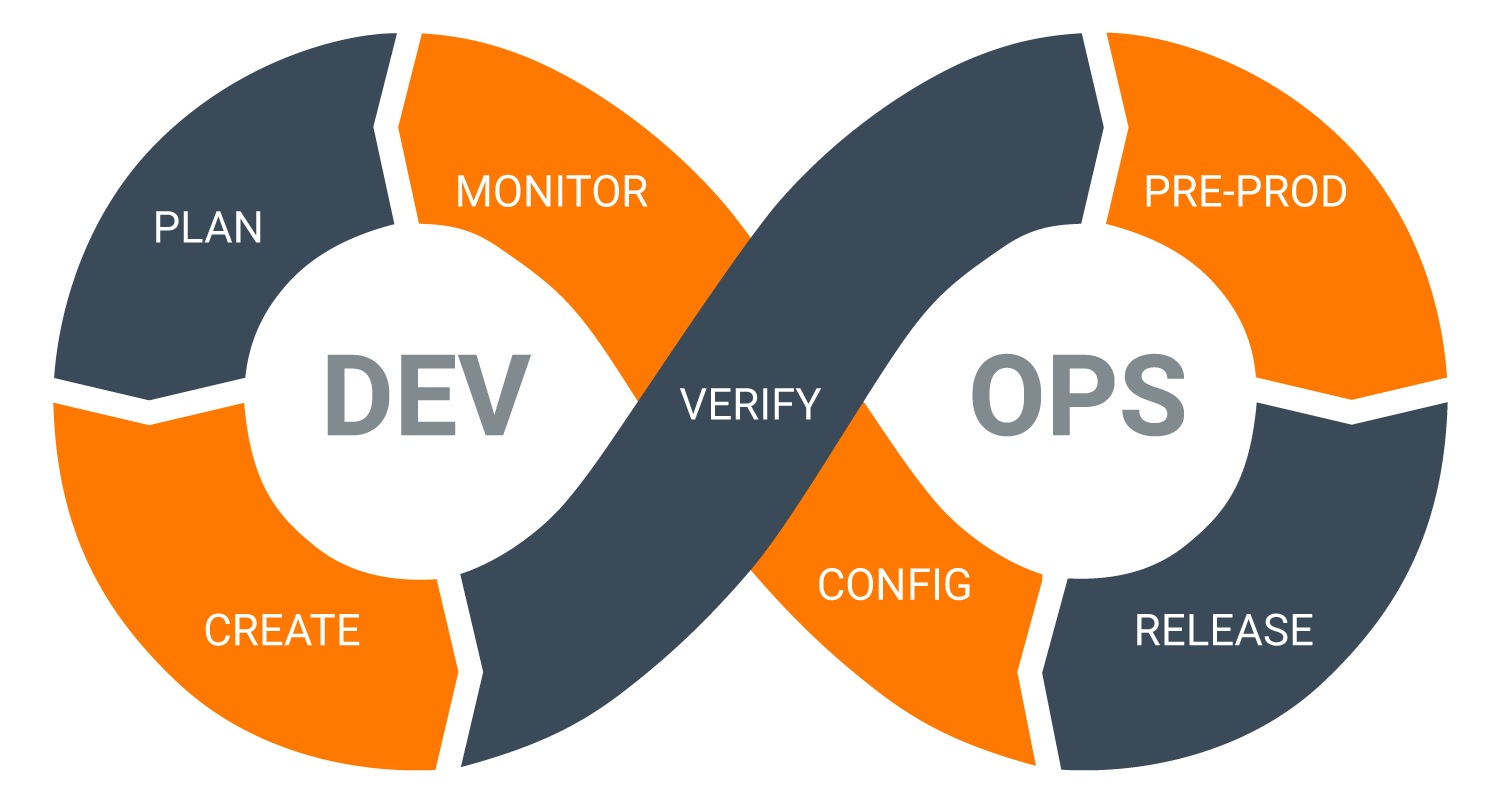
The DevOps Lifecycle, Tools, and Toolchain
The DevOps Lifecycle
The DevOps Lifecycle is a process of continual improvement and self evaluation to ensure that things are being done as quickly and as efficiently as possible, both in order to develop a quality product as well as maintain and upgrade that product. To this end, DevOps joins the development and operations teams to ensure maximum efficiency.
A DevOps toolchain is a set of the most effective tools for developing, delivering, and maintaining software. Establishing this toolchain is a good way to ensure that your company not only fully understands what is going to be required of them to make the transition but also to decide if the pains of making the transition will be worth it in the long run.
The concept of combining development and operations people together supports the goals of DevOps by improving collaboration between all stakeholders─from planning through delivery, and automation of the delivery process in multiple ways. This will help organizations:
- Improve deployment frequency
- Achieve faster time to market
- Lower failure rate of new releases
- Shorten lead time between fixes
- Improve mean time to recovery
This is accomplished by implementing and adhering to a straightforward lifecycle of activities:
- Continuous Development
- Continuous Integration
- Continuous Testing
- Continuous Monitoring
- Virtualization and Containerization
Clearly DevOps fosters a culture of continuous everything! The result is a much shorter iterative cycle of constant improvement with far shorter update cycles that accelerate the time to market while making it far easier to identify and correct deficiencies should they occur. The repeating cycle creates an effective process to follow when executing your DevOps initiative. The cycle is as follows:

- Be Agile
- Plan
- Build
- Test
- Release
- Configure
- Monitor
While monitoring progress of your DevOps lifecycle, you need to ensure that you are identifying pertinent information that ensures your business is agile and ready to start. Jez Humble, one of the founding developers of DevOps and author of The DevOps Handbook, points out that “DevOps is not a goal, but a never-ending process of continual improvement.”
A Life Cycle of Continual Improvement
Most of us are accustomed to periodic updates and upgrades. New features, new capacities, and new security provisions are introduced that make our software experience better. Some of these are ad hoc, distributed when a need, such as a security weakness, is identified and must be addressed immediately.
Most updates are distributed weekly or monthly. Upgrades usually take place less frequently. Major new version introductions often take years.
These are true for software applications that have been developed in the classic, monolithic way. Any change must be planned, designed, coded, prototyped, piloted, tested, and retested before distribution.
In cloud environments, monolithic application development no longer makes sense and has been superseded by microservices delivered in containers along with all libraries and other resources required to run them. These microservices are called upon as required. Should one become damaged in the course of transit or processing, it is instantly re-instantiated and re-distributed. This delivers a level of resilience and speed unavailable in monolithic development.
Similarly, today’s DevOps Lifecycle re-emphasizes the concept of “cycles.” Here, the cycles come far faster and more frequently. In DevOps, the developers and operators join forces to develop a culture in which they are constantly finding new, better, and faster ways to work. Leveraging their foundation in Agile development methodologies, they build new code in collaborative environments rather than silos, and they focus on “short yardage,” creating repetitive rounds of incremental improvement.
As soon as the developers have distributed new code, the operators step in and start generating and reporting user feedback. This vital information is fed back immediately to the developers who then assess the input and create code to build new solutions. Since each is a small component of a much larger environment they can be tested, packaged into their containers, released, configured, and distributed back out to the operators. At this point the operators step in again and start obtaining the next cycle of user feedback, starting the next cycle.
This repetition continues and continues, in a lifecycle of constant, continual improvement. Not only does this result in a product that has constant feedback─by allowing the operators to communicate their concerns directly to the developers and know that their feedback will be taken seriously─but also the overall speed in which updates are pushed out is greatly improved.
Continuous Lifecycle Process
Even though they are now working together collaboratively, it is useful to examine the steps both “Dev” and “Ops” execute in the course of the DevOps Lifecycle that forms the DevOps toolchain. Let’s enter right in the middle.
Steps in DevOps Lifecycle
Monitor – This is the first task in the DevOps toolchain. A major responsibility that falls to Ops is the constant monitoring of applications to assure optimum performance. However, this cannot end at simply monitoring.
Audit – Ensure a more thorough review than just monitoring. Ops must regularly audit the system surrounding each application to ensure that everyone is doing what they are supposed to be doing in a timely and efficient manner.
Diagnose – As problems are exposed, it is important that organizations diagnose what is the cause of the problems in order to establish the areas that need to be improved.
Tune – After an organization has diagnosed the problems, they need to tune any configuration parameters that are available to them in order to resolve the anomaly.
Feedback – Finally, the operations side of the DevOps toolchain wraps up with the feedback portion. If the operations team is not able to tune the configuration parameters to resolve the issue, the report of this anomaly becomes part of their regular feedback to the DevOps team for the next update.
As they expose weaknesses, they must diagnose the underlying root causes. If possible, they will tune any configuration parameters that are available to them in order to resolve the anomaly. If they are not able to do so, the report of this anomaly becomes part of their regular feedback to Dev.
Dev Task Cycle
Analyze – On the development side of the DevOps toolchain, analyzing the problem is the first step. As new feedback comes in, Dev analyzes it to determine root causes and identify opportunities for improvement.
Edit/Build – They may then edit existing code or, if this is not what is needed to fix it, build new microservices to resolve reported issues.
Test/Debug – Once the development team has corrected or conceived the problem, the changes and additions must be tested and debugged as necessary.
Deploy – Only after the team has tested and debugged the new product should they deploy the new microservices at which point Ops begins monitoring them.
Once the microservice is deployed, the process starts over and the lifecycle continues. Again, and again, and again. Continuous development, continuous integration, continuous improvement is what DevOps is all about and is what the DevOps toolchain looks to maximize.
Tools For Continuous Planning In DevOps
Think back to the introduction of any major new technological innovations and you’ll recall an explosion of tools and utilities surrounding that product or process. Eventually the strong survive, consuming some in the middle, and everyone else moves on.
DevOps is no exception. To span both development and operations several tools will obviously be required. The challenge is to choose the right DevOps toolchain tools to invest in the first time so you can preserve your investments as you grow. The DevOps toolchain is a great way to ensure that your organization is up to the task. It is as difficult a challenge with DevOps as it has ever been with any emerging methodology.
[adinserter name=”DevOps-Closing”]
Recent blog posts

Stay in Touch
Keep your competitive edge – subscribe to our newsletter for updates on emerging software engineering, data and AI, and cloud technology trends.



